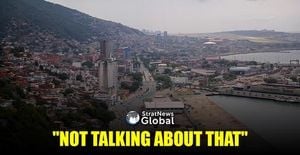Immigration and Customs Enforcement (ICE) agents have ramped up their operations across Colorado, significantly increasing the number of undocumented immigrants arrested, particularly focusing on the Denver metro area and cities such as Aurora. The decision to escalate enforcement actions stems from directives to conduct large-scale arrests, exemplifying the current federal administration's stringent stance on immigration.
According to reports, federal agents are carrying out these raids under directions to boost their target numbers, potentially reaching up to 1,500 arrests daily. By the end of January, sources claimed over 5,500 individuals had already been detained since operations intensified on January 23. Local police have noted these efforts occurring amid problematic narratives surrounding immigrant criminal activity.
Aurora, which recently gained unwanted attention for being labeled by former President Donald Trump as overrun with immigrant gang activity, is among the cities facing the brunt of ICE's increased enforcement. Trump previously used Aurora as part of his campaign rhetoric to bolster support for his anti-immigration initiatives, claiming it was rife with crime perpetuated by undocumented immigrants. Such characterizations have received pushback from local authorities, including Mayor Mike Coffman who highlighted, "The city is safe and there were isolated incidents involving gang members."
The operational shift began after ICE agents reportedly received instructions from field offices nationwide for more comprehensive enforcement activities, with plans to target three cities each week for larger operations. This heightened activity aligns with overall trends across the country, as Chicago and New York City have already experienced similar raids. While local officials were relatively tight-lipped about forthcoming operations when contacted for confirmation, preparations at locations like Buckley Space Force Base, repurposed as temporary detention facilities, indicate the scale of the federal efforts.
Among the affected individuals are those with criminal backgrounds, reinforcing ICE’s priority of detaining undocumented individuals who are perceived as threats to public safety. Three detainees recently taken from Routt County reflect this trend: Darwin Mejia-Cruz, Victoriano Cayetano Leon, and Nelson Martinez Espinoza, all previously arrested for various crimes.
Mejia-Cruz, arrested multiple times since 2015 for charges ranging from DUI to weapon offenses, is among those taken by ICE after bonding out of the local jail. Leon has been similarly charged with aggressive crimes and theft, illustrating the criminal histories ICE is leveraging when justifying these detentions. Sheriff Doug Scherar from Routt County reinforced ICE's focus by stating, "ICE is currently focusing on arresting undocumented individuals with criminal charges who are 'a threat to public safety.'" Disturbingly, his office reports limited direct cooperation with ICE due to state laws preventing compliance with immigration detainers for inmates.
These recent ramped-up operations have sparked concerns about the local community's safety and response. Many residents feel unsettled with such significant ICE presences, particularly against the background of Trump's previously inflammatory remarks about their city. Although local leadership attempts to maintain composure publicly, the fear remains palpable among immigrant communities. Despite ICE's narrative of safety and law enforcement, the deportation effects could lead to community fractures and fear of reporting crimes.
While the ICE is clear about their current enforcement directives, the broader ramifications of these policies are yet to be fully realized. The apprehension within Routt County reflects tension across communities encountering increased ICE activity and scrutiny. Local advocacy groups are keeping close tabs on how these operations will affect the legal rights of individuals and the broader social fabric of the communities targeted.
Aurora, particularly, is leaning on its law enforcement leadership to counteract the concerning portrayals from federal narratives. Having seen the effects of hostile immigration portrayals firsthand, local leaders stress the importance of fostering inclusive environments. The challenge will be how to rebuild trust amid these growing apprehensions, particularly as ICE's efforts do not appear to be waning. The stream of reports detailing increased arrests shows no signs of subsiding; keeping communities informed and engaged is becoming increasingly important for local officials.
While many continue to monitor the situation closely, the debate on immigration enforcement seems far from resolution. The response from grassroots organizations, local leaders, and immigrant communities will be integral as they navigate this complex and challenging moment.



